Download
in PDF Format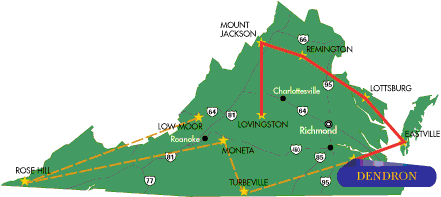
Like the trees it was named for, roots
in the town of Dendron run strong and deep.
Travelers passing through town on
Route 31 may not notice the subtle hints of the towns past, but the
peaceful atmosphere and old homes with inviting front porches are
impossible to miss.
The town of Dendron is located in
Surry County, and is home to about 300 people. It is situated about
halfway between the towns of Wakefield, on Route 460, and Surry, near the
James River. Incidentally, the history of the two towns and many other
communities in the area is deeply entwined with that of Dendron.
|
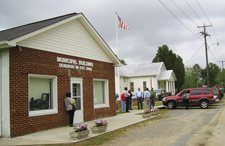
The
town hall sits in the middle of Dendron. Many residents active in
town business fill the hall for council meetings, held the first
Monday of each month. |
The area was once part of the Mussel
Fork Plantation. In 1881 a sawmill hand from New Jersey named David Steele
purchased this land, between the Blackwater River and Cypress Swamp, to
begin his own sawmill.
A few years later, an outfit from
Baltimore assumed control of the mill. This was the origin of the
successful Surry Lumber Company, which would forever change the
surrounding area.
The lumber company soon organized a
new railroad: the Surry, Sussex, and Southampton Railway or SS&S.
By narrow-gauge tracks, timber was brought out of Surry, Sussex, Prince
George, Isle of Wight, and Southampton counties to lumber mills in
Dendron.
The finished lumber products were then
shipped along the rails to Scotland Wharf, where steamboats transported
the goods down the James River and on to cities like Baltimore and
Philadelphia.
In Dendron's early days, the
SS&S provided a connection to many growing and future towns, like
Wakefield and Surry, along a 28-mile stretch. It provided passenger, mail,
and freight services to the communities along the railway, as well as
easier access and opportunities for commerce.
As the lumber company grew, the town
prospered. What was the mill village of Mussel Fork was renamed by the
Surry Lumber Company in 1896. The name Dendron was chosen.
Translated from its Greek origin, the word means tree. A charter
incorporating the town was granted by the General Assembly in
1906.
It was estimated that in 1918, Surry
Lumber Company's five mills employed 1,050 people each day. In the
1920s, there were nearly 3,000 people living in the Dendron area. It then
supported more than a dozen stores, two hotels, two schools, a jail, two
banks, two doctors, a skating rink, and a movie theater.
|
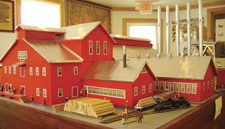
Melvin
Blizzard's model of Surry Lumber Company mill is on display at
Dendron Museum. |
At one time, more yellow-pine timber
was processed in Dendron than in any other mill east of the Mississippi.
However, as with many other areas in the South, the local timber supply
was eventually exhausted by logging. The mills closed in the fall of 1927.
The SS&S Railway made its final run in 1930.
The stores and businesses, one by one,
closed as well. Left without jobs, many of the Dendron residents moved
away to find work. In
spite of the setbacks, the people remaining in town were able to adjust to
a new lifestyle. Many people found it necessary to commute to other areas
for employment, wrote H. Temple Crittenden in his account of the mill
town, titled The Company.
The town evolved into a smaller,
quieter, and more tightly knit community. Many of the same families that
came to Dendron during its heyday still have descendants here. Even
current residents speak of the days of the Surry Lumber Company as if they
happened much more recently than 80 years ago.
|
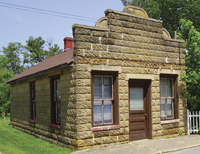
The
Bank of Dendron was once located in this quaint building on the
main street in town, Rolfe Highway. |
The fire of 1931 is also recalled
frequently when speaking of the towns history. There
was no fire brigade or volunteer fire department in Dendron at that time,
says Shelton Stewart, the towns current fire chief. The nearest fire
departments were in Norfolk, 50 miles east, or Petersburg, 40 miles west.
Both departments responded, but little could be saved. Nearly 30 buildings
perished.
The towns fire department was
organized later, in 1949. The original two-bay firehouse still stands, but
is now privately owned. The department, and its equipment, outgrew that
firehouse in the late 1970s.
The current home to the Dendron
Volunteer Fire Department was completed in 1984. A framed collage of
pictures documenting its construction hangs just inside the door.
As the sign says, it was a dream
come true, says Stewart in reference to the title printed on the
collage. We've come a long way.
There are 25 active members of the
Dendron Volunteer Fire Department. The volunteers serve one-third of Surry
County, an area of about 100 square miles. The volunteers respond to about
60 calls per year, Stewart estimates.
|
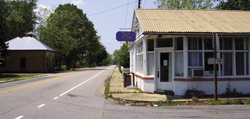
This
store has seen different proprietors over the years, but has
recently sat waiting for a new business to locate here. |
The volunteer firefighters in town
have a strong presence. When old enough, some firefighters children
have chosen to serve as well. Two of Stewarts own grandsons, Randy and
Joseph Gwaltney, are now active members. Stewarts wife, Jean Savedge
Stewart, has been a member for 29 years, and currently serves as secretary
and treasurer.
Were beginning to get more
younger members, and that's good, Stewart notes. The department has a
junior firefighter program that allows youth to volunteer, too.
Steak dinners, held as both a
fundraiser and a social event by the fire department, are popular among
the Dendron community. I think we could have one a month, laughs
Jean Stewart. We haven't had one yet this year, so everyone's
begging for one now.
In the fire departments early days,
donations to support the organization were collected at popular town
gatherings like dances and Ruritan Club suppers.
Another organization with strong
support from the community is the Dendron Historical Society, with about
200 members.
|

The
Dendron Volunteer Fire Department. Pictured: firefighters Dennis
Holmes, Wilbur Cornett, Joseph Gwaltney, Chief Shelton Stewart,
Roger Newby, Cody Bonner, and Jason Cornett. |
A group of local historians runs the
Dendron Museum, located adjacent to the town municipal building. Outside
of the Dendron Museum sits a boxcar from the SS&S Railway. It is
believed to be the only remaining car out of the original 70 that once
hauled lumber to Scotland Wharf.
After the boxcar had served its
purpose on the railroad, it was used as a corn crib on a nearby farm. The
owners donated it for preservation, and it was brought into town via
flatbed truck in 1997.
Bill Richardson, president of the
Historical Society, says the group formed then with the immediate task of
restoring the boxcar, which represented so much of the towns past.
The group hopes to build a second
structure to house the antique fire truck that served the town during the
early days of the Dendron Volunteer Fire Department. The departments
first fire truck has been carefully restored by Wally Faison, a town
resident.
We were trying to preserve the
history, Richardson explains, and noting the Surry Lumber Companys
influence. If it werent for the lumber company, Dendron wouldnt
be here.
It was the biggest thing between
Norfolk and Petersburg, he says of the Surry Lumber mills and the town
that grew around it.
Inside the museum, a photo album
offers a glimpse of what is left of the mill sites today. Pieces of the
foundations are still there, but are obscured by brush as the land has
begun reclaiming the former industrial sites. Sections of a horse barn and
three company houses are about all that remain, Richardson says.
The old Mussel Fork plantation house
is still standing, too, but is in much better condition. It was recently
moved and donated to the town of Dendron. There are no definite plans yet
for its future. The mayor says several local residents and historians have
made suggestions for its preservation that the town council will consider.
We were very glad to get it,
Mayor Yvonne Pierce says of the house, which now sits in a field just out
of sight from the main road.
Relationships are key
|

Business
is steady at the Dendron Market, a convenience store located in
the middle of town. |
Even though the community cherishes
these landmarks from the past, it values the memories and neighborly
relationships even more. Anecdotes and stories of
years past are easily recalled and shared. Helen Cooke Eggleston remembers
one such story about a neighborly prank. One Dendron gentleman named Mr.
Frank Dickerson would walk to the post office every morning, she said,
passing by Mr. Wilton Cooke's house. Wilton had a garden. He would
see Frank, peeping over there at his garden as he
walked by. Every day, he asked Wilton, There's no tomatoes out there
yet! What's wrong?
Wilton eventually tired of his
neighbors ribbing, and responded by tying red balloons to his tomato
vines. While making his morning walk the next day, Frank is said to have
done a double take at the new tomatoes on the vine but never
teased his neighbor about the plants again.
That's just the kind of
interaction, the good-natured relationships, that we have here,
Eggleston says.
Eggleston was born in Surry County,
and has lived in Dendron most of her life. She raised four children in
town. Several of her neighbors also had children of the same ages.
We always had a houseful of kids
running in and out, she says. They ran all over town, among the
houses, but we always knew where they were.
Most of the children who have grown up
in Dendron haven't had very far to travel to attend school. In the same
year that the town was incorporated, a four-room school was built on
Liberty Street. Smaller schools in the area were eventually consolidated,
and the Dendron school grew. In 1936, the Dendron school was one of the
county's three main institutions. For decades, the classes held there
varied, but the facility remained an anchor in local education. It was
torn down in the late 1970s.
Today, the Surry Elementary, L.P.
Jackson Middle, and Surry High schools are located just outside the town
limits. The district has about 1,030 students.
Lloyd Hamlin is the current
superintendent of Surry County Public Schools. He graduated from L.P.
Jackson High School in Dendron in 1964. After attending college, Hamlin
returned to the classrooms, no longer a student. I came back to teach
at L.P. Jackson, he says. It was a combined school at that time,
because it had elementary school and high school grades on the same
site.
Hamlin recalls that when he and his
classmates had attended L.P. Jackson, there was no gymnasium at the
school. We played outside, on a dirt court. In spite of that, we still
had some of the most successful basketball teams in the region, he says
with a smile.
Small-town allure
The small-town lifestyle is still
proving to be attractive to young families. We do
have new people coming into the area, notes the mayor. Some are
retirees, but the majority are families with children. Many of them are
coming back, because their parents or families are here.
The new residents, Yvonne Pierce
believes, have chosen Dendron as their home because of its atmosphere and
its location. She says she is pleased to see both new and established
families in town. Ive looked forward to working with citizens to
make it a better place to live, she says. I want people to come in
and be involved. The population is so small that were a family.
Everybody knows everybody.
Pierce has served on the town council
for 14 years, and was elected mayor in 2008. She has also worked for the
county school system for more than 30 years.
With its roots entrenched in the
timber industry, the town is now facing a new prospect of business and
innovation. Old Dominion Electric Cooperative announced last year that it
was considering a site in town for a prospective coal-fired base-load
power-generation facility.
Although the lumber mills, the steam
locomotives, and the loggers are now only a memory of the past, history is
very much a part of Dendron. It is unforgettable and undeniable
simply in referring to Dendron, the town built from the trees.